A Study of Solutions for Some Classes of PDEs Arising in Physics and Engineering Using Modified Reduced Differential Transform Method
Abstract
This paper successfully employs a combined methodology that integrates the reduced differential transform approach, Laplace transform, and Padé approximants to solve diverse partial differential equations with real and complex variables. The proposed method, known as the modified reduced differential transform method (MRDTM), extends the interval of convergence with less computing time. An interesting aspect of this method is its capability to produce an analytic exact solution with only a few computable terms. The paper provides practical applications through notable examples encompassing the Klein–Gordon equation, the Schrödinger equation, the nonlinear reaction–diffusion–convection equation, and systems of linear and nonlinear PDEs. Primary results on certain test problems demonstrate the efficiency and ability of the method in solving diverse classes of partial differential equations, and therefore, it can be used as an alternative for dealing with such problems that do not have analytic solutions.
1. Introduction
Partial differential equations (PDEs) have been essential in presenting complete and truthful models for various scientific phenomena, particularly in the chemical, physics, biological sciences, and engineering disciplines. The nonlinear Klein–Gordon equation in quantum field theory and design of optoelectronic devices, systems of PDEs and Schrödinger’s equation in quantum mechanics, and reaction-diffusion-convection equations in population dynamics and heat conduction are a few examples of PDEs that are fundamental for understanding real-world dynamics. These equations were originally derived from expertise in mathematical modeling and supported by observations. Seeking solutions to such equations is crucial for understanding natural phenomena.
Numerous techniques have arisen for solving different types of differential equations such as the homotopy perturbation method (HPM) [1–4], homotopy analysis method (HAM) [5, 6], generalized homotopy method [7], variational iteration method (VIM) [8], Adomian decomposition technique (ADM) [9, 10], Galerkin technique [11–13], spline method [14–19], finite element method (FEM) [20–22], and block method [23]. However, many of these methods face challenges related to computational efficiency, slow convergence rates, or restrictions in the domain of convergence, especially for nonlinear PDEs or systems of PDEs.
Among these methods, the reduced differential transform (RDT) method (RDTM) [24–26] has gained recognition as an efficient and powerful variant of the differential transform method (DTM) [27, 28] as it reduces computational costs while maintaining accuracy. This approach expresses the solution as an infinite power series with rapidly convergent successive approximations. Moreover, RDTM has proven highly effective in attaining exact and approximate solutions for computational modeling, showcasing its convenience and reliability, and providing comparative simplicity over other methods [29–34]. However, a significant limitation of RDTM is that the truncated series solution often exhibits convergence issues over a restricted domain [35], limiting its effectiveness for broad classes of PDEs.
To address this limitation, this study introduces a modified version of RDTM, which integrates RDTM with the Laplace transform and Padé approximants. This hybrid approach enhances convergence rates, expands the convergence domain, and results in exact solutions. Compared to existing methods such as B-spline methods and FEM, MRDTM offers a semianalytical framework that avoids mesh usage and computationally expensive iterative schemes while confirming higher accuracy. The effectiveness of MRDTM is demonstrated through its application to various PDEs, including the Klein–Gordon equation, nonlinear reaction-diffusion-convection equation, Schrödinger’s equation, and systems involving both linear and nonlinear PDEs.
The remaining structure of this paper is as follows: Section 2 delves into the methodology, exploring the RDT and Padé approximation. Section 3 outlines the main results, demonstrating the application of RDTM to a nonlinear PDE. Section 4, titled “Implementations,” demonstrates MRDTM’s efficiency through seven examples. Section 5 discusses results, evaluating MRDTM’s accuracy, stability, and convergence. Finally, Section 6 concludes the paper, summarizing findings and suggesting a recommendation for future implementations.
2. Preliminaries
In this section, we lay the groundwork for our research by providing a preliminary discussion of two key methodologies: the RDT and Padé approximation. This critical examination sets the stage for a deeper understanding of the methods employed in our study.
2.1. RDT
We delve into the foundational concepts and mathematical operations of the RDTM to enhance comprehension of the method presented in this section.
Definition 1 ([24]). Let ψ(ξ, τ) be an analytic and continuously differentiable function, then the RDT is expressed as
Definition 2 ([24]). The inverse RDT of Ψn(ξ) is defined as
Table 1 shows the main mathematical properties of RDTM. For the proofs of these properties, refer to [36–38].
| Original formψ(ξ, τ) | Transformed formΨn(ξ) |
|---|---|
| λϕ(ξ, τ) ± γω(ξ, τ) | λΦn(ξ) ± γΩn(ξ) |
| ξiτj | ξiρ(n − j), |
| ξiτjϕ(ξ, τ) | ξiΦn−j(ξ) |
| ϕ(ξ, τ) · ω(ξ, τ) | |
| ϕ(ξ, τ) · ω(ξ, τ) · ν(ξ, τ) | |
| Sin(λξ + γτ) | |
| Cos(λξ + γτ) | |
| eγτ |
2.2. Padé Approximation
These equations are solved to obtain the values of b that, when substituted, give a unique formulation for the coefficients a. The nonsingularity of these equations ensures a direct solution.
Note that, for a constant value of r + s + 1, Error (6) is the lowest when the degree of the numerator and denominator of Equation (4) is the same or when the denominator is one degree smaller than the numerator. For more information on the Padé approximant, please refer to [39, 40].
3. Main Results
4. Implementations
The primary aim of this section is to demonstrate the application of MRDTM through the following examples, demonstrating the method’s accuracy and effectiveness. Numerical results for Examples 1–7 are displayed in Tables 2, 3, 4, 5, 6, 7, and 8 and Figures 1, 2, 3, 4, 5, 6, 7, 8, 9, 10, 11, and 12. Within these tables, the terms ψE, , and Eψ denote the exact solution, the sixth-order approximate solution of RDTM, and the absolute error of ψ, respectively.
Example 1. Consider the nonlinear Klein–Gordon equation:
| τ = ξ | ψE | Eψ | |
|---|---|---|---|
| 0 | 0 | 0 | 0 |
| 0.2 | 0.1960133156 | 0.1960133156 | 1.27 × 10−11 |
| 0.4 | 0.3684243911 | 0.3684243976 | 6.49 × 10−9 |
| 0.6 | 0.4952011200 | 0.4952013689 | 2.49 × 10−7 |
| 0.8 | 0.5573620622 | 0.5573653675 | 3.31 × 10−6 |
| 1 | 0.5402777778 | 0.5403023059 | 2.45 × 10−5 |
| τ = ξ | ψE | Eψ | |
|---|---|---|---|
| 0 | 0 | 0 | 0 |
| 0.2 | 1.3108321938 | 2.6216649889 | 6.01 × 10−7 |
| 0.4 | 2.5276057834 | 5.0553164486 | 1.05 × 10−4 |
| 0.6 | 4.3676026484 | 8.7373993667 | 2.19 × 10−3 |
| 0.8 | 7.3112965335 | 14.6421514858 | 1.96 × 10−2 |
| 1 | 12.0863354267 | 24.2827641839 | 1.10 × 10−1 |
| τ = ξ | Numerical results ofψ | ||
|---|---|---|---|
| ψE | Eψ | ||
| 0 | 2 | 2 | 0 |
| 0.2 | 2.4918246945 | 2.4918246976 | 3.18 × 10−9 |
| 0.4 | 3.2255404182 | 3.2255409285 | 5.10 × 10−7 |
| 0.6 | 4.3201059893 | 4.3201169227 | 1.09 × 10−5 |
| 0.8 | 5.9529296646 | 5.9530324244 | 1.03 × 10−4 |
| 1 | 8.3884410254 | 8.3890560989 | 6.15 × 10−4 |
| τ = ξ | Numerical results ofϕ | ||
| ϕE | Eϕ | ||
| 0 | 0 | 0 | 0 |
| 0.2 | 0.0000000030 | 0 | 3.03 × 10−9 |
| 0.4 | 0.0000004617 | 0 | 4.62 × 10−7 |
| 0.6 | 0.0000094093 | 0 | 9.41 × 10−6 |
| 0.8 | 0.0000841064 | 0 | 8.41 × 10−5 |
| 1 | 0.0004787285 | 0 | 4.79 × 10−4 |
| τ = ξ | Numerical results ofψ | ||
|---|---|---|---|
| ψE | Eψ | ||
| 0 | 1 | 1 | 0 |
| 0.2 | 1.4918246945 | 1.4918246976 | 3.18 × 10−9 |
| 0.4 | 2.2255404182 | 2.2255409285 | 5.10 × 10−7 |
| 0.6 | 3.3201059893 | 3.3201169227 | 1.09 × 10−5 |
| 0.8 | 4.9529296646 | 4.9530324244 | 1.03 × 10−4 |
| 1 | 7.3884410254 | 7.3890560989 | 6.15 × 10−4 |
| τ = ξ | Numerical results ofϕ | ||
| ϕE | Eϕ | ||
| 0 | 1 | 1 | 0 |
| 0.2 | 1.0000000030 | 1 | 3.03 × 10−9 |
| 0.4 | 1.0000004617 | 1 | 4.62 × 10−7 |
| 0.6 | 1.0000094093 | 1 | 9.41 × 10−6 |
| 0.8 | 1.0000841064 | 1 | 8.41 × 10−5 |
| 1 | 1.0004787285 | 1 | 4.79 × 10−4 |
| τ = ξ | Numerical results ofψ | ||
|---|---|---|---|
| ψE | Eψ | ||
| 0 | 0 | 0 | 0 |
| 0.2 | 0.2426552717 | 0.2426552686 | 3.10 × 10−9 |
| 0.4 | 0.5809443847 | 0.5809439008 | 4.84 × 10−7 |
| 0.6 | 1.0288557364 | 1.0288456663 | 1.01 × 10−5 |
| 0.8 | 1.5965971273 | 1.5965053406 | 9.18 × 10−5 |
| 1 | 2.2878872056 | 2.2873552872 | 5.32 × 10−4 |
| τ = ξ | Numerical results ofϕ | ||
| ϕE | Eϕ | ||
| 0 | 1 | 1 | 0 |
| 0.2 | 0.8024106473 | 0.8024106473 | 5.20 × 10−11 |
| 0.4 | 0.6174056370 | 0.6174056479 | 1.09 × 10−8 |
| 0.6 | 0.4529535614 | 0.4529537891 | 2.28 × 10−7 |
| 0.8 | 0.3130486476 | 0.3130505040 | 1.86 × 10−6 |
| 1 | 0.1987570870 | 0.1987661103 | 9.02 × 10−6 |
| τ = ξ | ψE | Eψ | ||
|---|---|---|---|---|
| ERe(ψ) | EIm(ψ) | |||
| 0 | 0 | 0 | 0 | 0 |
| 0.2 | 0.1897960607 − 0.0587108103i | 0.1897960610 − 0.0587108017i | 3.2 × 10−10 | 8.6 × 10−9 |
| 0.4 | 0.3214006654 − 0.2198842881i | 0.3214008270 − 0.2198821360i | 1.62 × 10−7 | 2.15 × 10−6 |
| 0.6 | 0.3509814156 − 0.4423526300i | 0.3509873900 − 0.4422996437i | 5.97 × 10−6 | 5.3 × 10−5 |
| 0.8 | 0.2598642525 − 0.6691038508i | 0.2599395423 − 0.6686039153i | 7.53 × 10−5 | 5.0 × 10−4 |
| 0 | 0.0590015788 − 0.8421283840i | 0.0595233027 − 0.8393630887i | 5.22 × 10−4 | 2.77 × 10−3 |
| τ = ξ | ωE | Eω | ||
|---|---|---|---|---|
| ERe(ω) | EIm(ω) | |||
| 0 | 1 | 1 | 0 | 0 |
| 0.2 | 0.9205312086 + 0.3920318557i | 0.9210609940 + 0.3894183423i | 5.30 × 10−4 | 2.60 × 10−3 |
| 0.4 | 0.6883989768 + 0.7370056845i | 0.6967067093 + 0.7173560909i | 8.31 × 10−3 | 1.96 × 10−2 |
| 0.6 | 0.3217000334 + 0.9914675773i | 0.3623577545 + 0.9320390860i | 4.07 × 10−2 | 5.94 × 10−2 |
| 0.8 | −0.1516607592 + 1.1185039848i | −0.0291995223 + 0.9995736030i | 1.22 × 10−1 | 1.19 × 10−1 |
| −0.6968150780 + 1.0894832831i | −0.4161468365 + 0.9092974268i | 2.81 × 10−1 | 1.80 × 10−1 | |

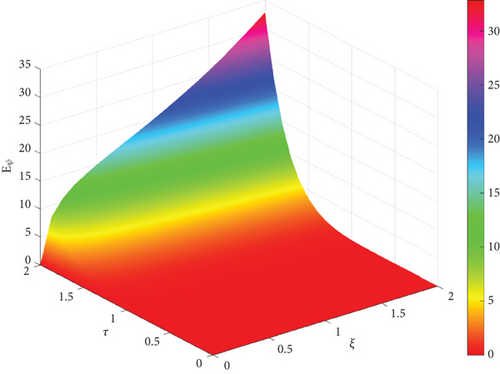
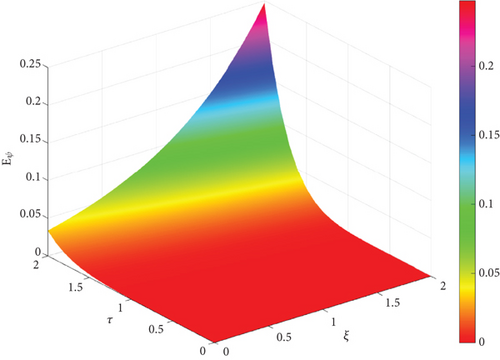
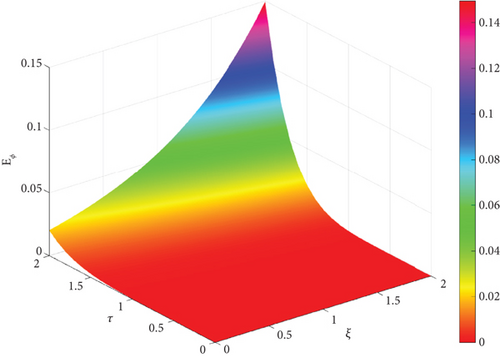
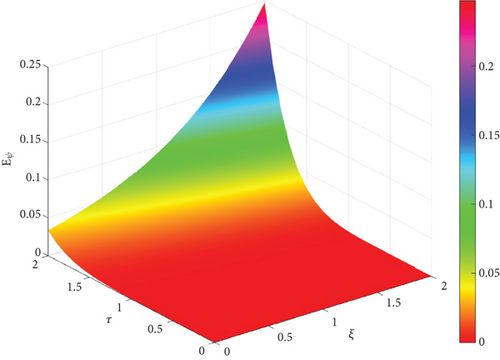
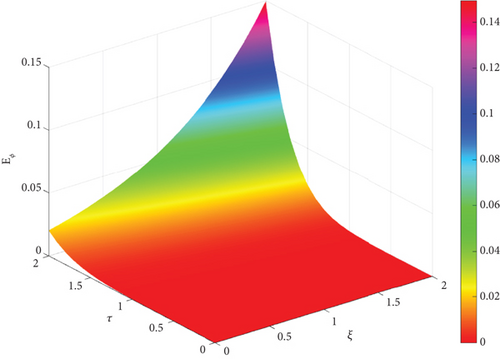
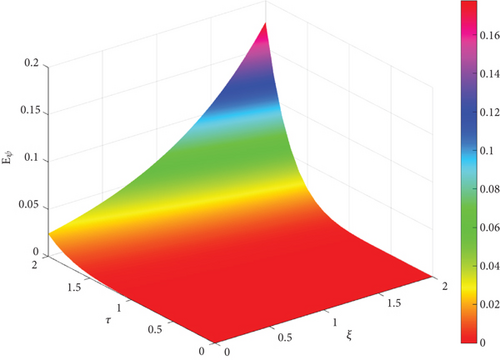
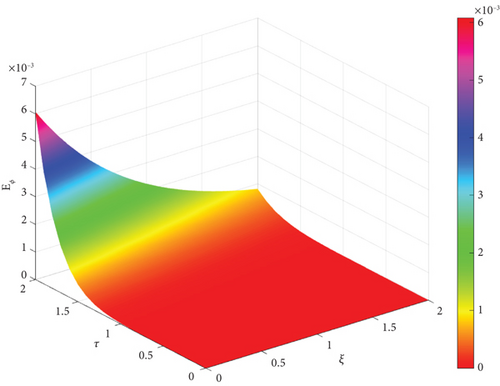
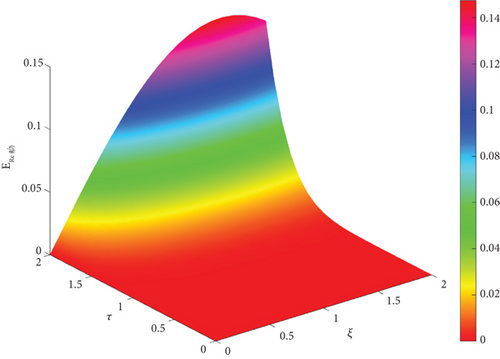
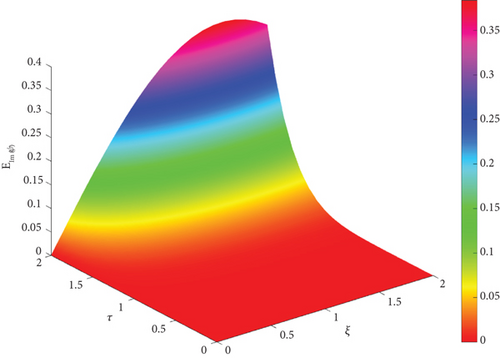
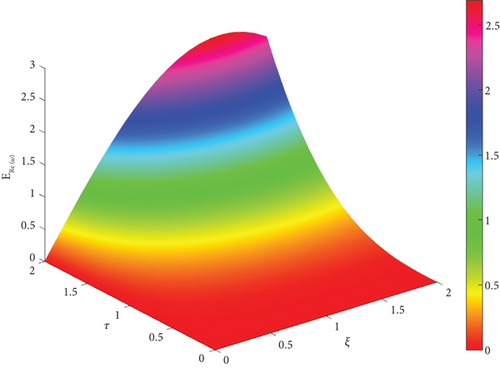
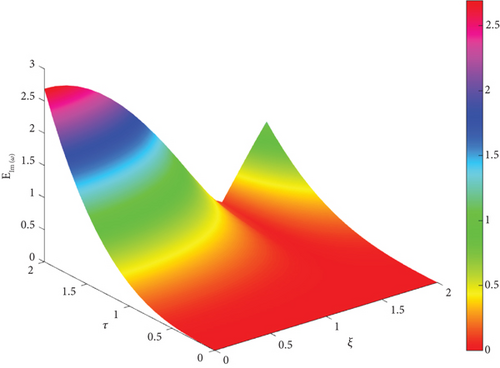
Example 2. Consider the nonlinear reaction-diffusion-convection equation:
Example 3. Consider the following system of linear PDEs:
Example 4. Consider the following system of nonlinear PDEs:
Example 5. Consider a system characterized by two nonlinear equations:
Example 6. Consider the following Schrödinger equation:
Example 7. Consider the following system:
5. Results and Discussion
To provide a thorough evaluation of MRDTM, we present numerical and graphical analyses highlighting its accuracy, stability, and convergence behavior compared to RDTM. One key observation is that MRDTM yields analytical solutions, regardless of the complexity of the governing equation. This characteristic is particularly valuable in applications such as engineering and physics, where even minor numerical discrepancies can lead to significant errors in practical computations. Furthermore, a closer examination of the graphical trends reveals that MRDTM converges at a near-instantaneous rate for smooth PDEs while maintaining its efficiency even in cases where nonlinearities are dominant.
Error propagation is a common issue in numerical analysis, especially with nonlinear or coupled PDEs. Traditional methods, such as finite difference and spectral approaches, often require stability constraints or corrective steps to prevent error buildup. MRDTM eliminates these concerns by using Laplace transforms and Padé approximants to construct solutions directly. Tables 2, 3, 4, 5, 6, 7, and 8 in this study show that absolute errors remain within computational precision, effectively mitigating truncation-induced inaccuracies. Furthermore, error plots confirm MRDTM’s stability across various problem structures, even for PDEs with strong nonlinearities or complex boundary conditions. Unlike finite difference and spectral methods, MRDTM does not accumulate residual errors over iterations, making it particularly effective in high-precision computational modeling, such as quantum mechanics simulations, where numerical instability can significantly affect results.
As ξ and τ move further from 0, RDTM’s accuracy decreases, as seen in the growing absolute error (Eψ). This highlights RDTM’s limitation in maintaining precision over a broader variable range. In contrast, MRDTM consistently produces exact solutions across all tested values, demonstrating its resilience in solving complex systems without accuracy loss. The figures illustrate this clearly, showing RDTM’s increasing absolute error as ξ and τ grow, reinforcing MRDTM’s reliability. The numerical tables further highlight its advantage, comparing MRDTM’s exact solutions with RDTM’s truncated series approximations. The results emphasize MRDTM’s superior precision, particularly in cases where traditional methods struggle to sustain accuracy.
Examining the method’s convergence behavior highlights another key strength. Unlike iterative techniques, where convergence refers to an approximation progressively approaching the true solution, MRDTM provides a direct formulation that avoids successive refinements. The main question is how efficiently it performs across different PDE types. Our results show that it converges rapidly with significantly fewer terms than conventional series-based methods. This advantage is particularly evident in problems with higher-order nonlinearities, where standard approaches require extensive terms to achieve reasonable accuracy. The combination of Laplace transforms and Padé approximants accelerates the process, making it highly effective in applications such as aerodynamics, wave propagation, and material science. Furthermore, for equations with steep gradients or discontinuities, where spectral methods often struggle with Gibbs phenomena, it maintains accuracy without introducing oscillatory artifacts. A comparative study with alternative solvers could further highlight its advantages in handling problems with varying smoothness properties.
Beyond numerical validation, the practical significance of MRDTM cannot be overlooked. The equations examined in this study, including the Klein–Gordon equation, the Schrödinger equation, and reaction–diffusion models, are fundamental in many scientific and engineering applications. Obtaining exact solutions for these equations without numerical artifacts or instability is a major advantage in fields such as semiconductor physics, structural analysis, and computational fluid dynamics (CFD). Furthermore, MRDTM’s ability to handle both real and complex-valued problems extends its applicability beyond theoretical research. In engineering simulations, where PDEs govern material behavior, thermal systems, and electromagnetic waves, having an exact analytical solution minimizes the need for extensive parameter tuning and iterative corrections, making MRDTM a compelling alternative to traditional numerical solvers. One example of this advantage is in CFD, where high-precision solutions for the Navier–Stokes equations are essential for aerodynamic simulations. The efficiency of MRDTM in handling complex nonlinear PDEs suggests its potential as a valuable tool in CFD applications, reducing computational costs while ensuring accuracy in turbulence modeling.
Future work could explore its integration with hybrid analytical–numerical techniques or machine learning models to extend its applicability even further. However, as it stands, MRDTM offers a stable, efficient, and highly accurate framework for solving PDEs in physics, engineering, and applied mathematics. While MRDTM proves to be highly effective in this study, certain limitations remain. The current analysis has primarily addressed a specific class of PDEs with relatively straightforward boundary conditions. Extending this approach to more intricate boundary constraints or higher-dimensional models may necessitate further adaptations to preserve its computational efficiency and accuracy. Moreover, although the method demonstrates strong performance across the selected test cases, its effectiveness in handling highly stiff systems warrants additional investigation. Overcoming these challenges opens avenues for future research to broaden the method’s applicability to a wider spectrum of complex problems.
6. Conclusion
This research highlights the potency of MRDTM as a robust and effective tool for solving a wide range of PDEs. These classes of PDEs encompass nonlinear PDEs with real and complex variables, as well as systems of linear and nonlinear PDEs. Our findings indicate that the integration of this technique successfully enables MRDTM to find exact solutions for the considered PDEs. We begin the procedure by obtaining a series solution for the PDE via RDTM. Next, we utilize Laplace transform to RDTM truncated series solution to expand the convergence domain, enhancing the method’s effectiveness. Padé approximants are used to truncate series and acquire a meromorphic function, thus significantly contributing to the attainment of exact solutions. Finally, the required solution is attained by the inverse Laplace transform.
The efficiency of the method is demonstrated by successfully finding the exact solutions. The proposed examples demonstrate that the method greatly enhances the convergence rate, expands the convergence domain, and leads to exact solutions. MRDTM can handle diverse classes of PDEs, underscoring its potential utility in mathematics and engineering, where exact solutions are often sought but elusive.
Conflicts of Interest
The authors declare no conflicts of interest.
Funding
This research did not receive any specific external funding.
Open Research
Data Availability Statement
No underlying data was collected or produced in this study.




